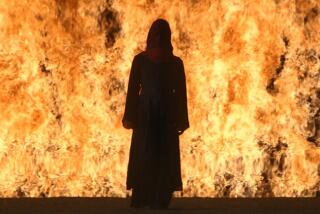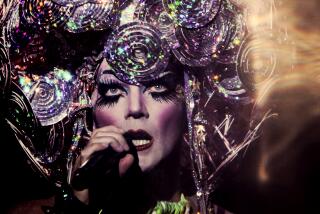A Promethean effort
- Share via
Two survivors emerged from a pile of bodies toward the end of Paul Taylor’s abstract dance-drama “Promethean Fire” at the Dorothy Chandler Pavilion on Saturday, isolated in red light as if illuminated by nearby flames.
As they began to dance, anger and desperate need consumed them, but soon more couples entered to amplify their anguished duet and transform it into a large-scale statement of acceptance and hope.
Choreographed early in 2002 to massive orchestral arrangements of Bach, “Promethean Fire” used 16 members of the Paul Taylor Dance Company to evoke the dismay and solidarity of an America seen as both victim and oppressor in the last few years.
Taylor didn’t tie his imagery to any specific event, so the work seems to update itself for every new milestone in brutality that we’ve faced. And it suggests that we’re strong enough to prevail.
Mass keening, or dancers crawling brokenly to some imagined safety, represented one extreme of Taylor’s vision. But he created a potent counterforce in the corps protectively cradling one another, and the nobility of Lisa Viola and Michael Trusnovec in the climactic duet. Santo Loquasto put the dancers in sleeveless black unitards ringed with spirals and chevrons -- costumes that were not quite funereal but still somber.
In “Promethean Fire,” lighting designer Jennifer Tipton helped conjure up an unseen urban environment, but in “Runes” (on the same three-part Music Center program), she turned the stage into a pitch-dark outdoor nightscape, complete with full moon rising.
This enigmatic 1975 rite began with the ensemble’s attempts to raise a fallen comrade (Richard Chen See). Next, it expanded to a class in ritualistic lore and then increasingly focused on individuals before the finale erupted in dynamic group jumping. George Tacet’s costumes, accented with pieces of fur, further augmented the neo-primitive context.
Viola danced a solo of fast, sharp, birdlike changes with her usual authority; Trusnovec matched her in a solo with no steps but constant shifts of position and whirlwind hands, then joined Annmaria Mazzini for a duet full of frenzied interplay that included sudden, spectacular jumps and catches.
However, “Runes” stayed too dark too long and the over-amplified piano score by Gerald Busby made listening to it as problematic as seeing it. Taylor aimed for a mysterious fragment of a lost culture, but on Saturday it was compromised by modern theater technology.
Happily, Tipton made even the night sky brightly glow in “Mercuric Tidings.” This 1982 showpiece to symphonic Schubert again found Trusnovec in a lead role, partnering Silvia Nevjinsky as if they were completely alone while, in fact, the ensemble surged around them.
Costumed in mottled red by Gene Moore, the cast faced complex technical challenges -- including high-velocity turning-jumps with the feet tucked up -- but Taylor always humanized corps unisons with passages spotlighting individual variations on a step or combination.
Taylor worked in plenty of jokes as well: Trusnovec taking a few moments off to recline center stage and watch his colleagues zoom by. Or leaving the stage completely empty while dancers wave at one another from the wings. Or having the cast strike a triumphal pose at the very end to honor Parisa Khobdeh, a dancer who had no major moment in the entire piece.
Miraculously, all these fake-outs blossomed spontaneously from the music, so “Mercuric Tidings” had the effect of an impromptu game played by young people for their own pleasure.
How fresh yet curiously distant it seemed. “Runes” may have aimed at being an artifact of a vanished epoch, but for audiences in 2004, “Mercuric Tidings” captures something almost as remote: the endless optimism of late 20th century America.
We’ve grown up in ways we never could have predicted since then, and so has Taylor. “Promethean Fire” is the evidence.
More to Read
The biggest entertainment stories
Get our big stories about Hollywood, film, television, music, arts, culture and more right in your inbox as soon as they publish.
You may occasionally receive promotional content from the Los Angeles Times.










